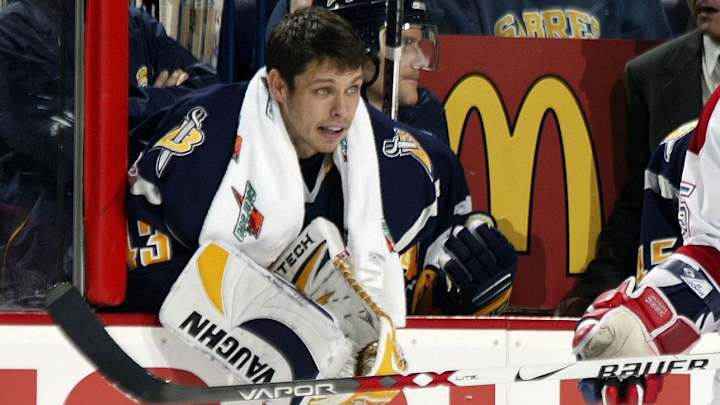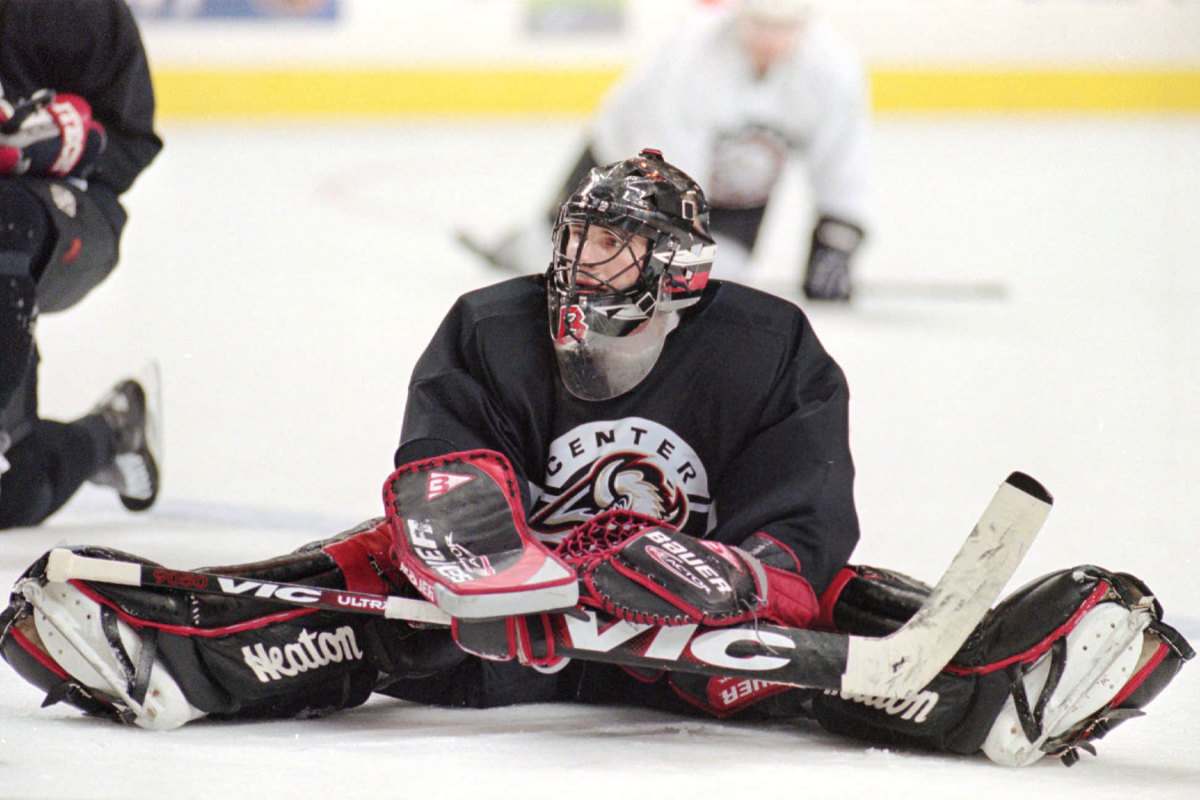It's hammer time: More tales from the NHL’s second-string goalies

Upon your next visit to an NHL rink, arrive early and pay special attention to warmups. Which side of the ice you watch matters not. Right around the same moment in their pregame routines, both teams usually perform the same ritual sacrifice.
It begins during the three-line drill, as skaters tee off against the starting goaltender. The shots are hard but harmless, taken from deep near the blue line, intended to help loosen the man in the net more than anything else. When the starter decides he’s finished, he waves his glove and signals for relief. Up comes the backup, who’s been waiting in the corner. In rush the skaters, abandoning the structure and firing on the fly. The drill, ostensibly, is over. The backup does not stand a chance.
“It’s hammer time,” Minnesota Wild goalie Devan Dubnyk says.
“You’ve got to get the hell out of the way,” former goalie Steve Shields says.
Among the occupational hazards of the backup life, explored in last week’s SI, many stem from situations like this. While expected to hop onto the ice in a pinch, cold and idle from sitting on the bench, often in lopsided games that have spun out of control, the No. 2 goalie also receives no meaningful pregame warmup, save perhaps the standard game of Last Puck—another beat-up-on-the-backup situation in which every skater crowds in close and together try to score.
It’s barely different in practice. Retired goalie Martin Biron remembers one time when a teammate accidentally struck the starter in the throat guard. The coach immediately halted practice and went berserk. “If you want to shoot high,” he coach roared, pointing at Biron, “shoot high on Marty at the other end.”
Being No. 2: Hockey’s cushiest gig is also one of its toughest
Though for every backup’s bruise comes a list of stories gathered along the way, the benefit of their unique position. They are invested in the game, of course, but not at the level of their teammates. This allows them to sit back, watch and even occasionally, in the case of those buttery-bun hot dogs in Montreal or the personal pizzas in Detroit, enjoy some leftovers as you are about to do.
***
When goalie Chris Mason reached the NHL with Nashville, he grew close with Pete Rogers, the head equipment manager. As Predators games unfolded in front of them, this friendship manifested itself in a strange way on the bench.
“We just had this theme,” says Mason, who now provides commentary on the team’s radio network. “It started when we were really into the show 24. Some of it doesn’t even make sense. But we pretended we were part of the CTU—Counter Terrorism Unit. It was all these missions that we had.” Here’s one of them: Whenever an equipment representative for Warrior was in attendance, Mason and Rogers would race to spot him into the rink. That’s it. That’s the mission.
“It evolved into, we talked to each other like we’re actual agents,” Mason says. “Just stupid, funny s--- like that.”
Their code names came from equally random origins. “It was back when the goalies were flaring out the insides of their knee pads,” Mason says. “They were cracking down on goalie equipment. We’d watch, look for goalies with those, then we’d call it ‘The Thing’ that comes out the side. So we were both The Thing. He’s the top agent, and I’m the second in command. Thing 1 and Thing 2. We still refer to each other as that.”
***
In Nov. 2010, long before he won the Vezina Trophy and tied Martin Brodeur’s single-season wins record, Braden Holtby was just a young minor-league goalie with a massive bursa on his right ankle. “It was there for two or three years,” he says. “I didn’t wear sandals or shorts for that whole time.”
The inflamed, fluid-filled sac grew so large that Holtby’s fellow Hershey Bears nicknamed it after his two roommates, defensemen Sean Collins and John Carlson. Creatively enough, it was called SeanJohn. “They’d always make fun of it all the time,” Holtby says. “If you lost a bet you had to touch it. It was the size of a tennis ball. It’d hang over the top of my skate. But it wasn’t infected, so they wouldn’t drain it.”
Anyway, this became particularly relevant on Nov. 5, 2010, midway through the third period in Boston. By then Holtby had been with the Washington Capitals for roughly a month, but hadn’t yet made his NHL debut. Heading into the third period, the Capitals had taken a comfortable 3-0 lead over the Bruins. SeanJohn, meanwhile, was barking. “Didn’t think anything of it,” Holtby says. “I untied my skate because it hurt so bad. And start of the third, it was just like, bang-bang-bang, three goals against.” So coach Bruce Boudreau called for his backup, loose lace and all.
“Didn’t have my skate tied up, so I played the next little while with my skate untied,” says Holtby, who finished the game by saving all four shots he faced, earning his first career victory in the process. “So the first TV timeout, I’m having my whole pad off, tying my skate. My legs were shaking so bad, trying to tie my skates I was vibrating, I was so nervous.”

***
Far as we can tell, Toronto’s Mike Babcock is the only NHL coach who assigns his backups in-game homework, handing them a clipboard to chart faceoffs. (Disciples Todd McLellan and Bill Peters have been known to in the past, but at least not this season.) An informal survey of goalies, both current and retired, somewhat unsurprisingly revealed that they’d rather just watch and relax.
“It’s stressful,” says Holtby, who played for Babcock at the 2016 World Cup of Hockey. “You’ve got four coaches yelling at you, getting the faceoffs, and you can’t see most of the time. [Chicago’s Corey] Crawford had to do it too, and in the first game took a puck right to the forehead.”
Like Babcock, some see value in keeping their backups mentally occupied and engaged. “Now that I’m a coach, I make the goalies chart a lot of stuff,” says Shields, now on staff at the University of Michigan. Though this admittedly might’ve originated in a selfish place. “My biggest pet peeve was what I thought was a shot on goal, compared to what the shot keeper thought,” Shields says. “If I was in a particular mood, I would keep track of their exact shots, then get the message up to the keeper if he was wrong. I would write it down. You’d start to know the officials around the rink. Sometimes I’d keep track of the shots, then if I saw him, I’d say ‘Why did you only have eight shots in that period? I thought there were 10.’”
The savvy amateur statisticians know how to multi-task. “You try to make a few bucks on the side there,” says former journeyman goalie Brian Boucher, now with NBC Sports. In other words, goose the faceoff numbers for a price. “It depended on the status of the centerman. If it was Big Joe [Thornton in San Jose], he makes pretty good money, so you can raise the rate on a guy like him, at least $100 a faceoff. If it’s a fourth-line guy, call-up, take it easy for him, maybe $25.
The Replacements: Workhorse goalies no key to long playoff run in 2016
“You’re a backup goaltender making league minimum and living in Silicon Valley there, it’s tough to get ahead, right? You’ve got to find ways to make a couple extra bucks on the side, especially if you’re not good at playing cards.”
At least Boucher, though, was mindful of the action on the ice. “I never really did any other charting of anything during the game,” Biron says, “other than charted how many times a song was played or how many times they did stupid games on the Jumbotron.”
***
The first commandment of the backup life: Always be ready. When Johan Hedberg was backing up Kari Lehtonen for Atlanta, Lehtonen one time walked straight off the ice midgame, without saying a word, and disappeared into the tunnel. “I have no idea what’s going on,” Hedberg says. “Ok, then he comes back out. What happened? His contact was bad and he went to change his contact lens.”
The second commandment: It’s never about you, so stop bitching. “No one has use for a negative backup goalie,” says Steve Valiquette. “I can’t tell you how many times [Jaromir] Jagr came up to me, said he wants to try out his new stick, and I’m hanging in there after practice for hours. We had a breakaway competition at the end of practice. I created this game, because I had to find a way to do something competitive with Jagr, otherwise I’d do a thousand breakaways. I had to find a way to get him off the ice. I created a best 4 out of 7 game. They’d still take like 15, 20 minutes. The point of it really is, you have to do whatever the guys want you to do. Go out, give the guys a chance to win, be the best teammates on earth.”
***
At Nationwide Arena in Columbus, site of Montreal’s recent hang-drying of goalie Al Montoya in a 10-0 loss, visiting backups sit on a stool in the tunnel behind the bench. At the Canadiens’ rink, they watch from the entryway across the ice, isolated entirely from their teammates, and in Carolina they’re in the Zamboni tunnel.
In Chicago, there’s no space anywhere. “You get to sit in the dressing room, watch it on TV, have a coffee, stretch out a little bit,” Holtby says. “It’s the best.”
***
The last word goes to Shields.
“If you’re looking closely,” he says, “you’ll see guys are up to things. In Buffalo, the trainer once slid the bench phone right under my arm, and said, ‘Here’s your dad.’ I said, ‘Dad?’ He was at home watching in Ontario. He said, ‘What the hell are you doing? Get off the phone.’”
